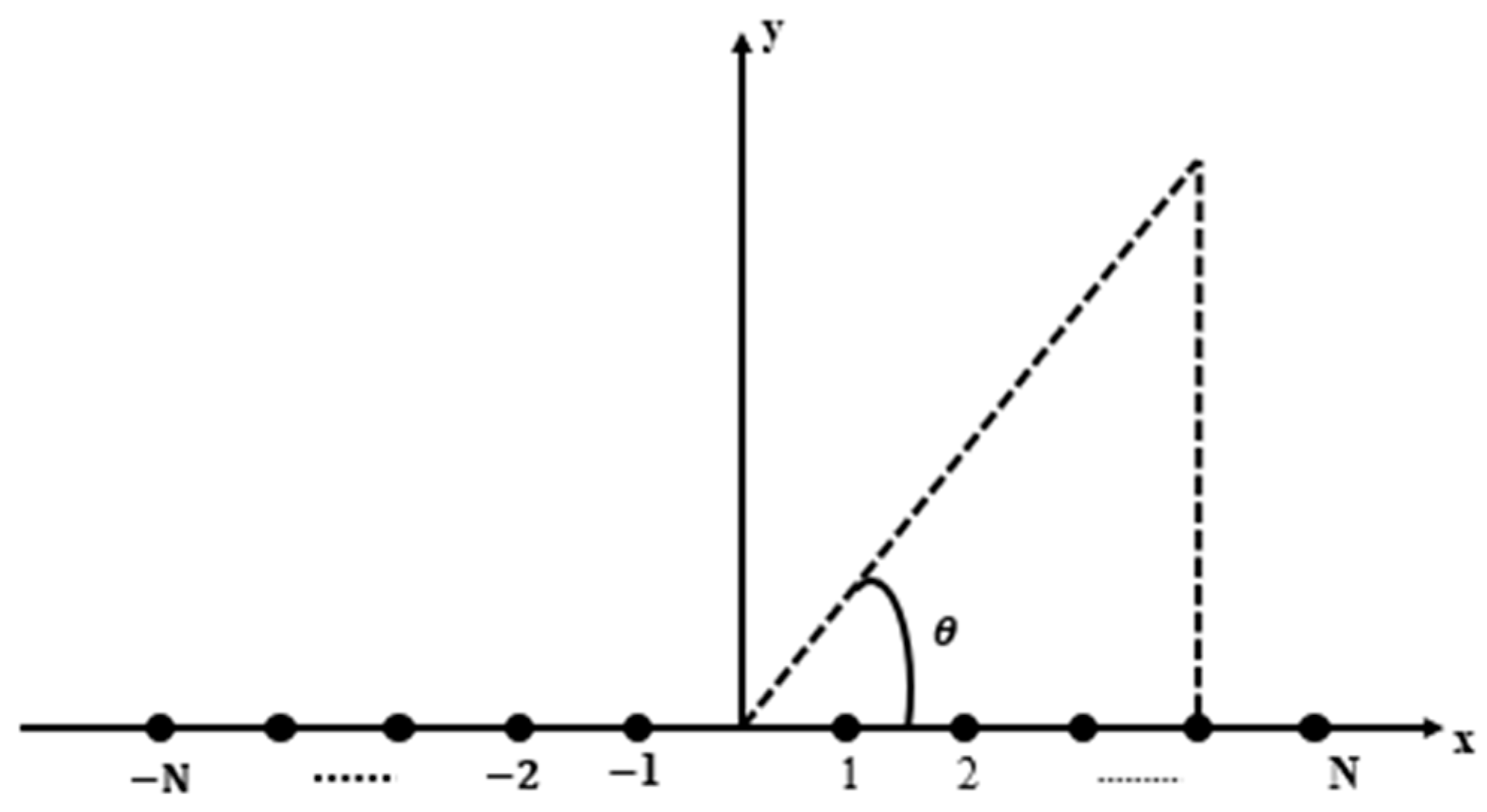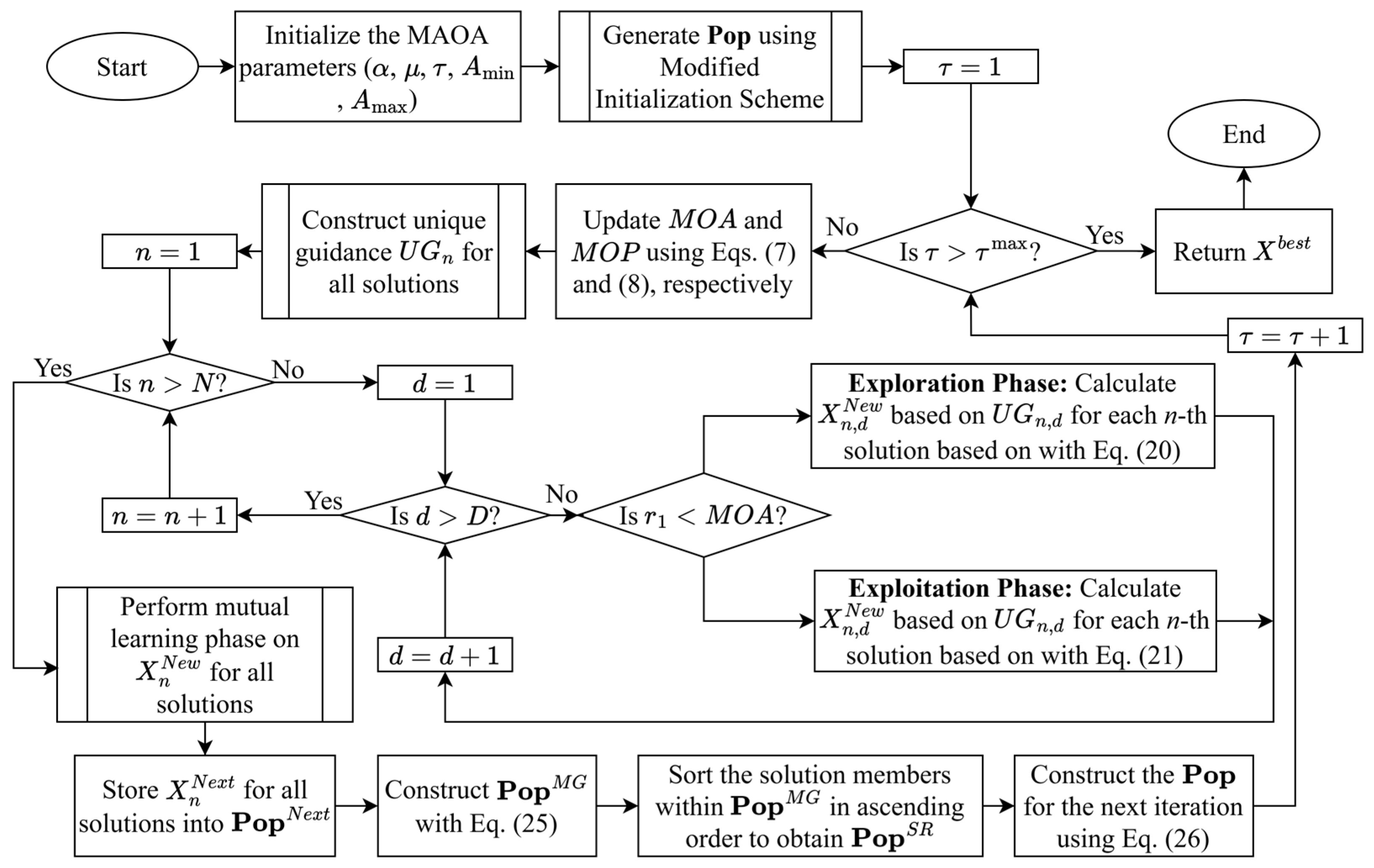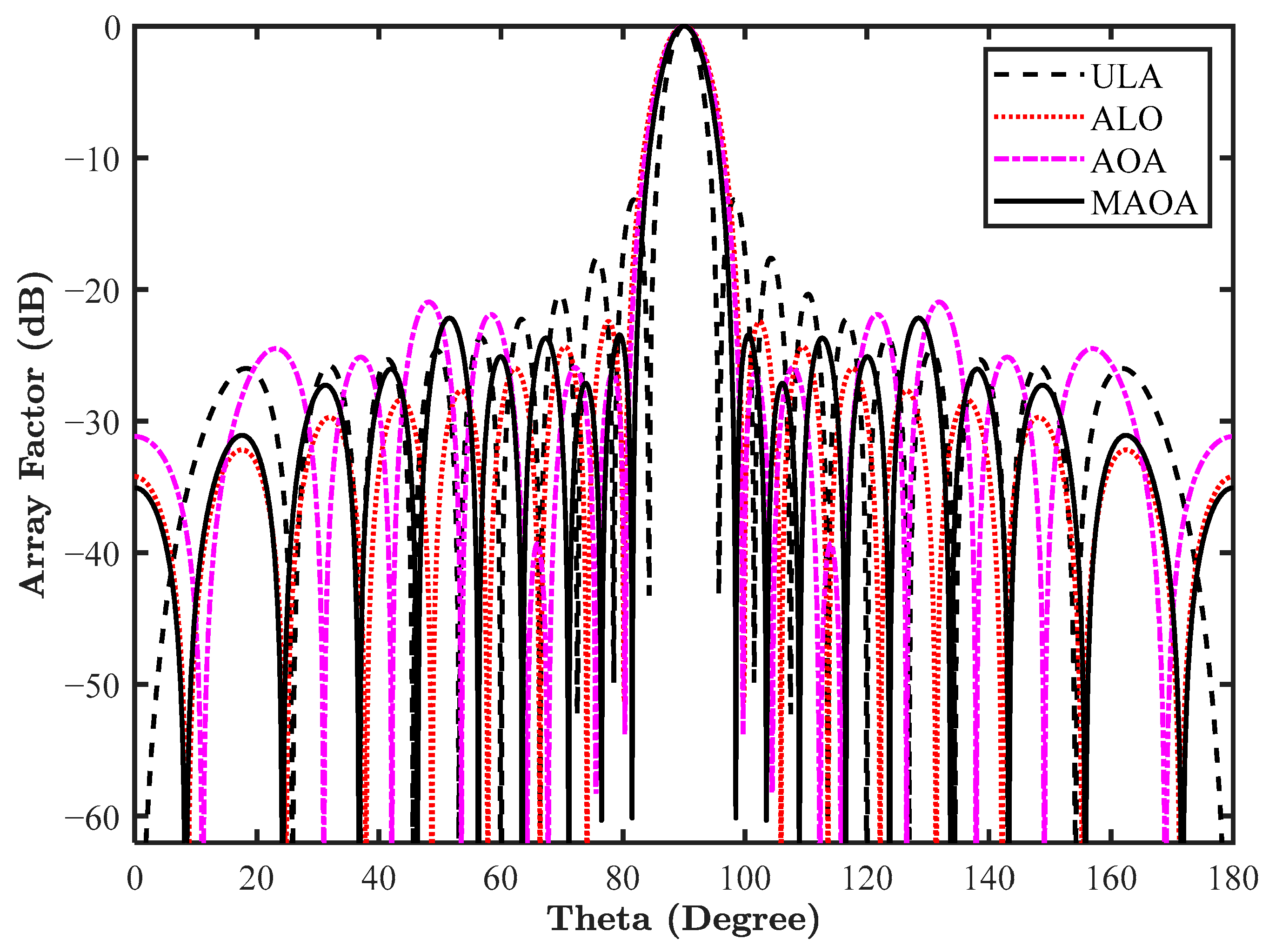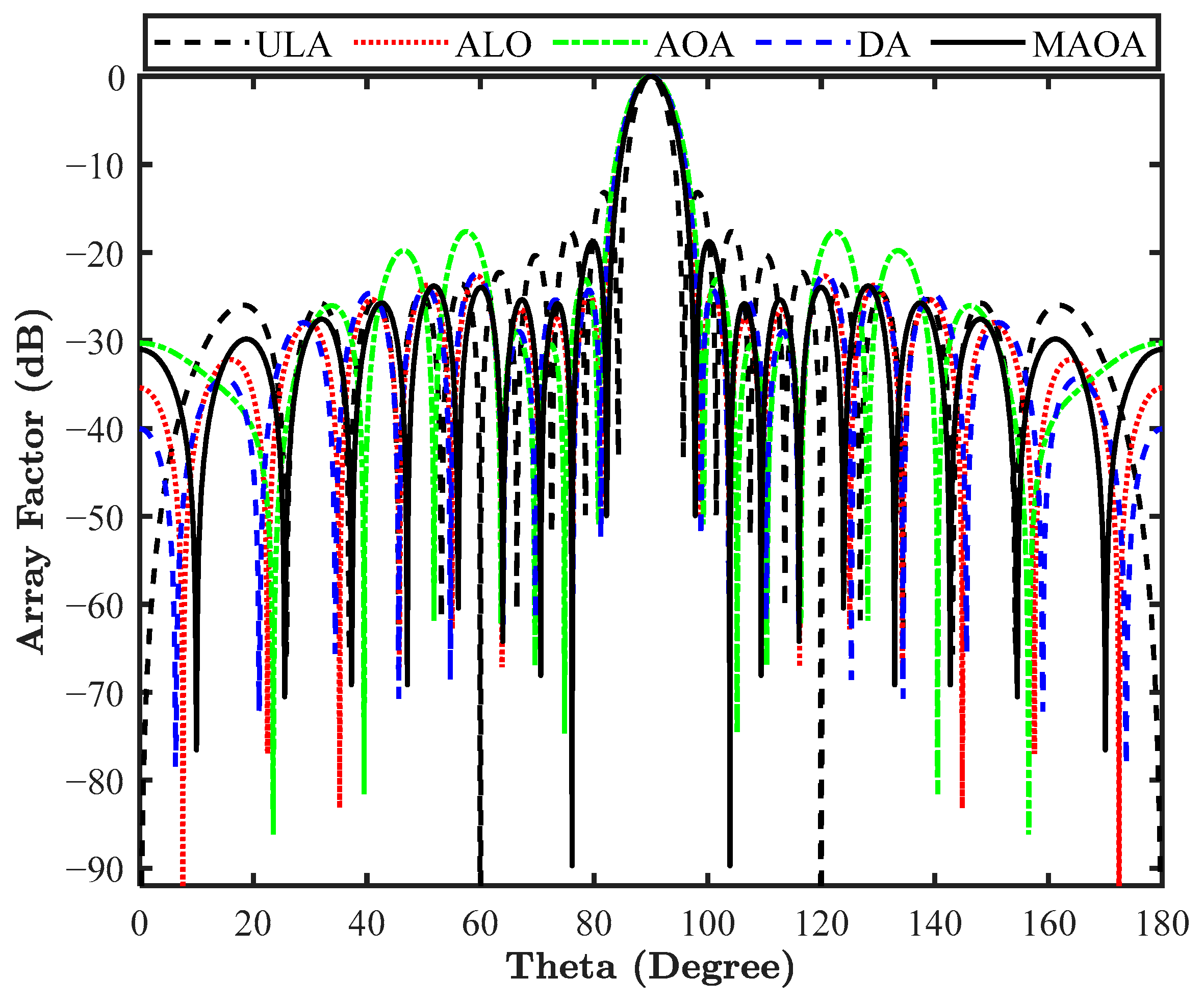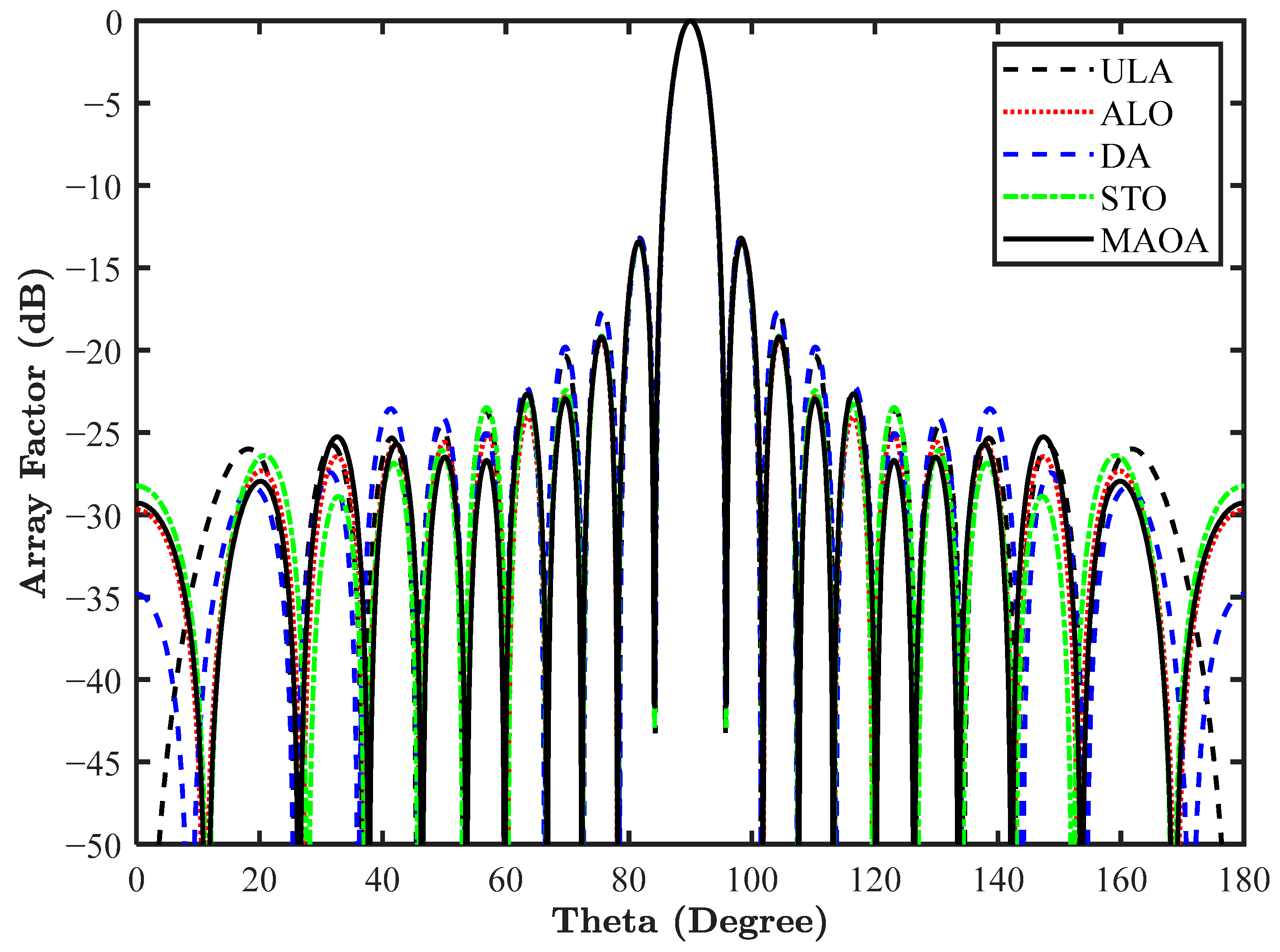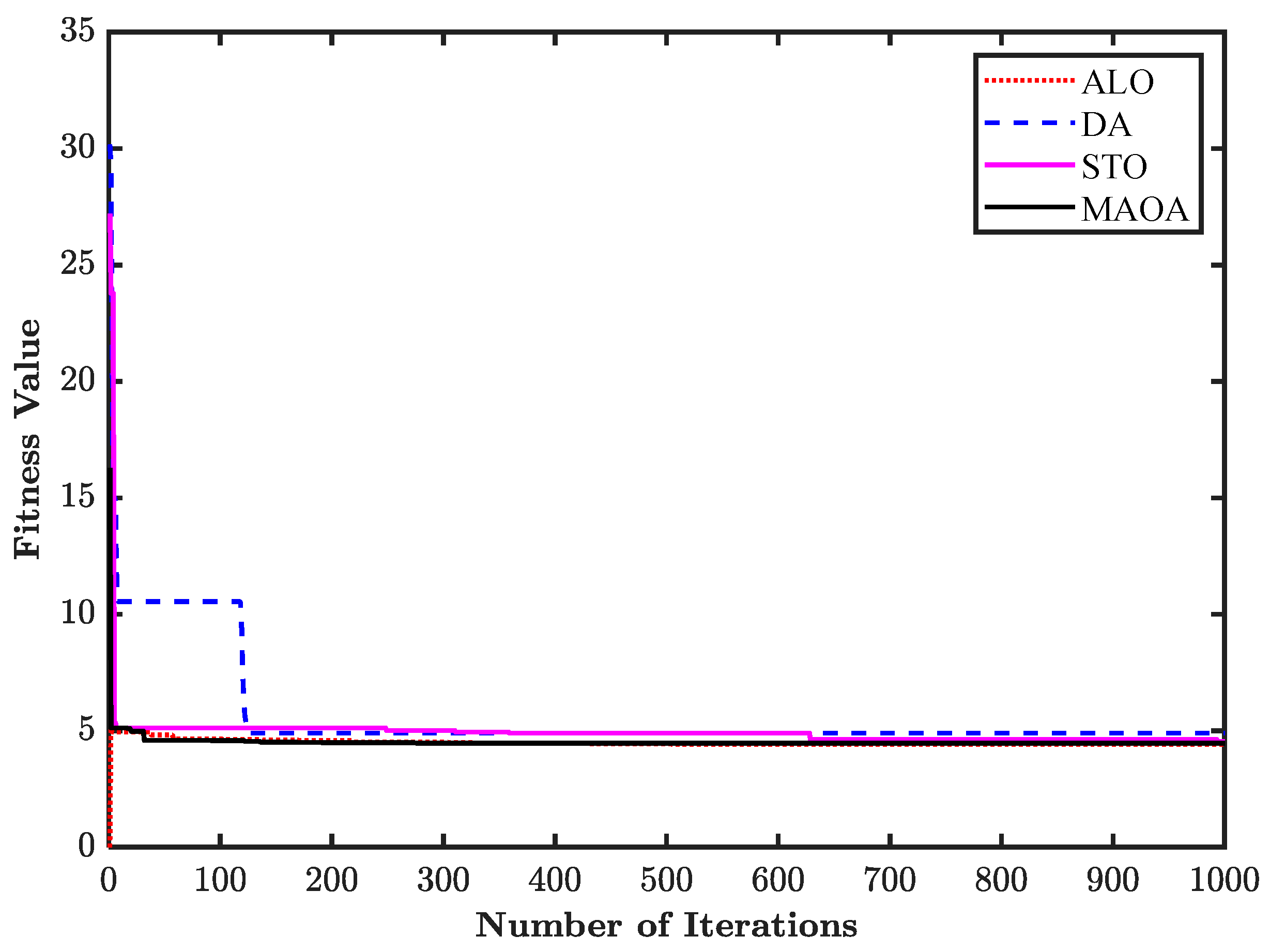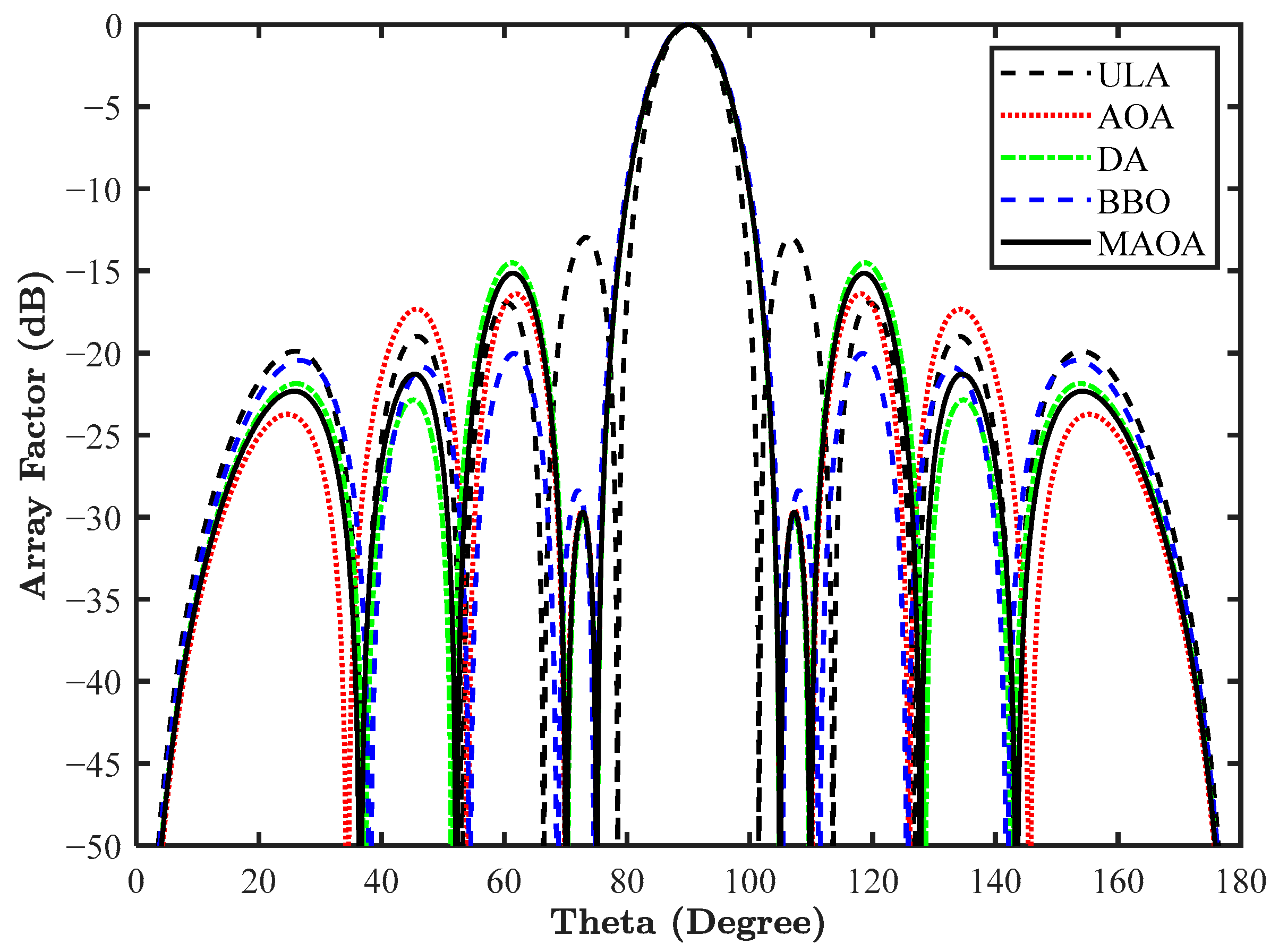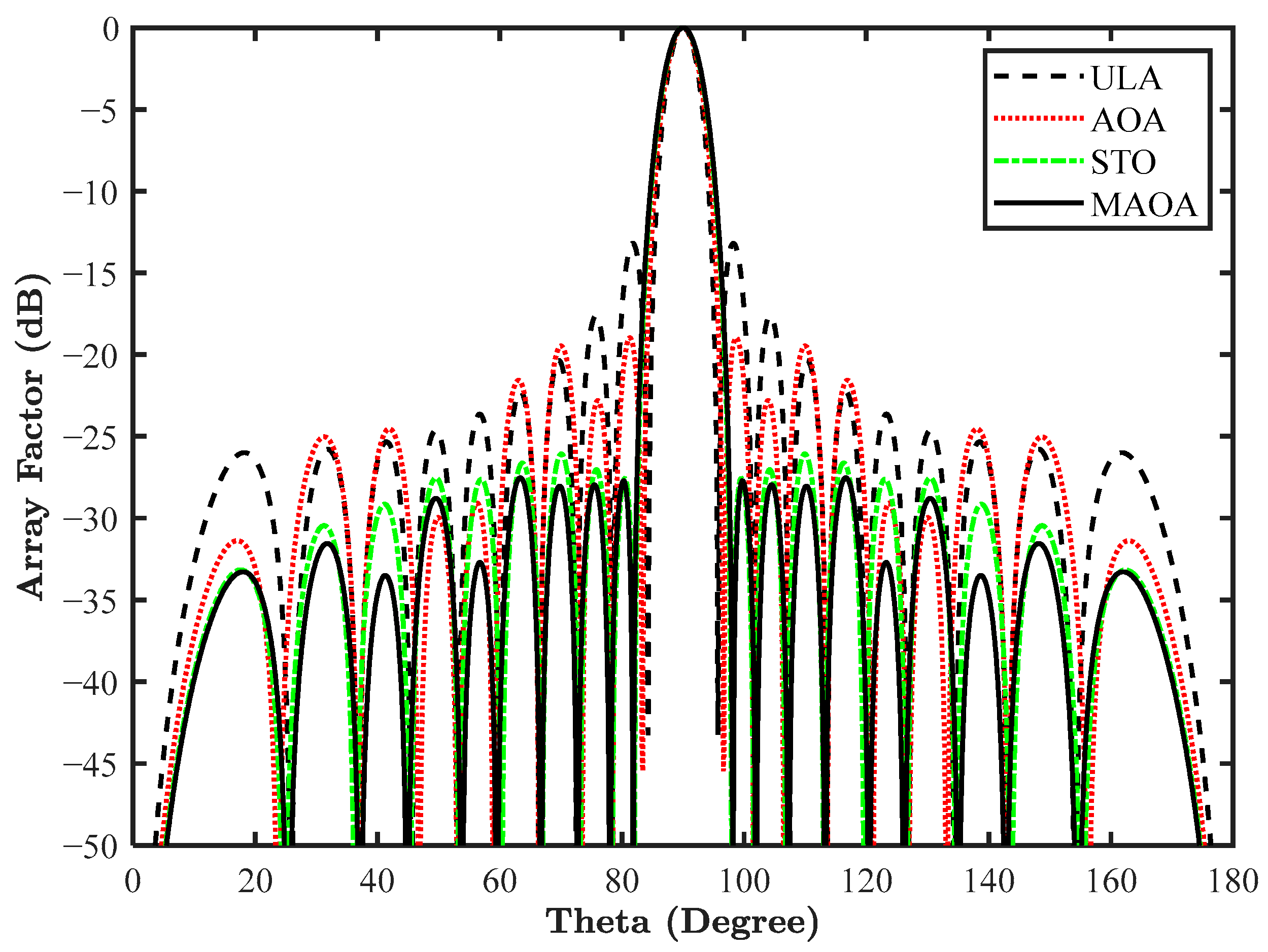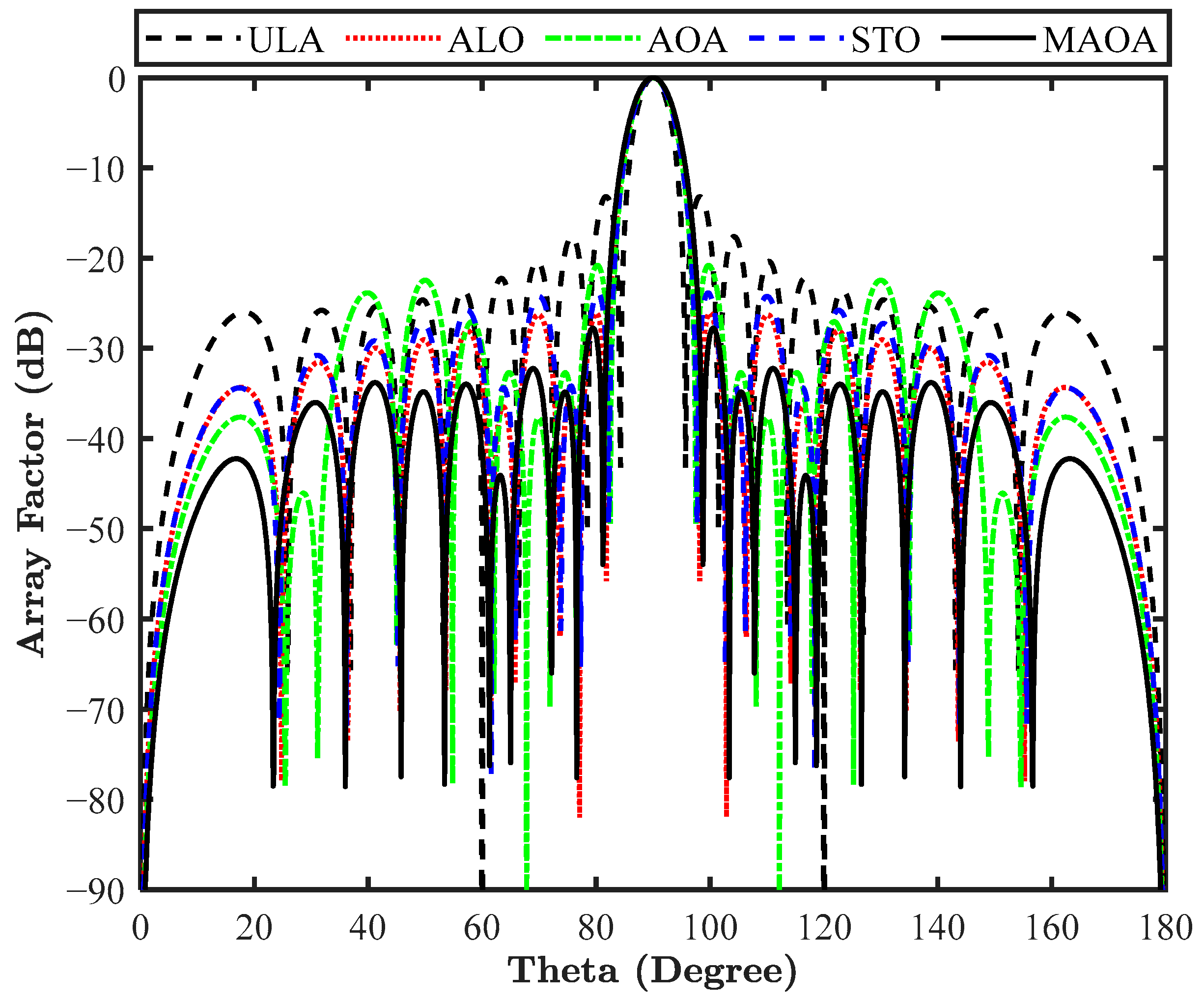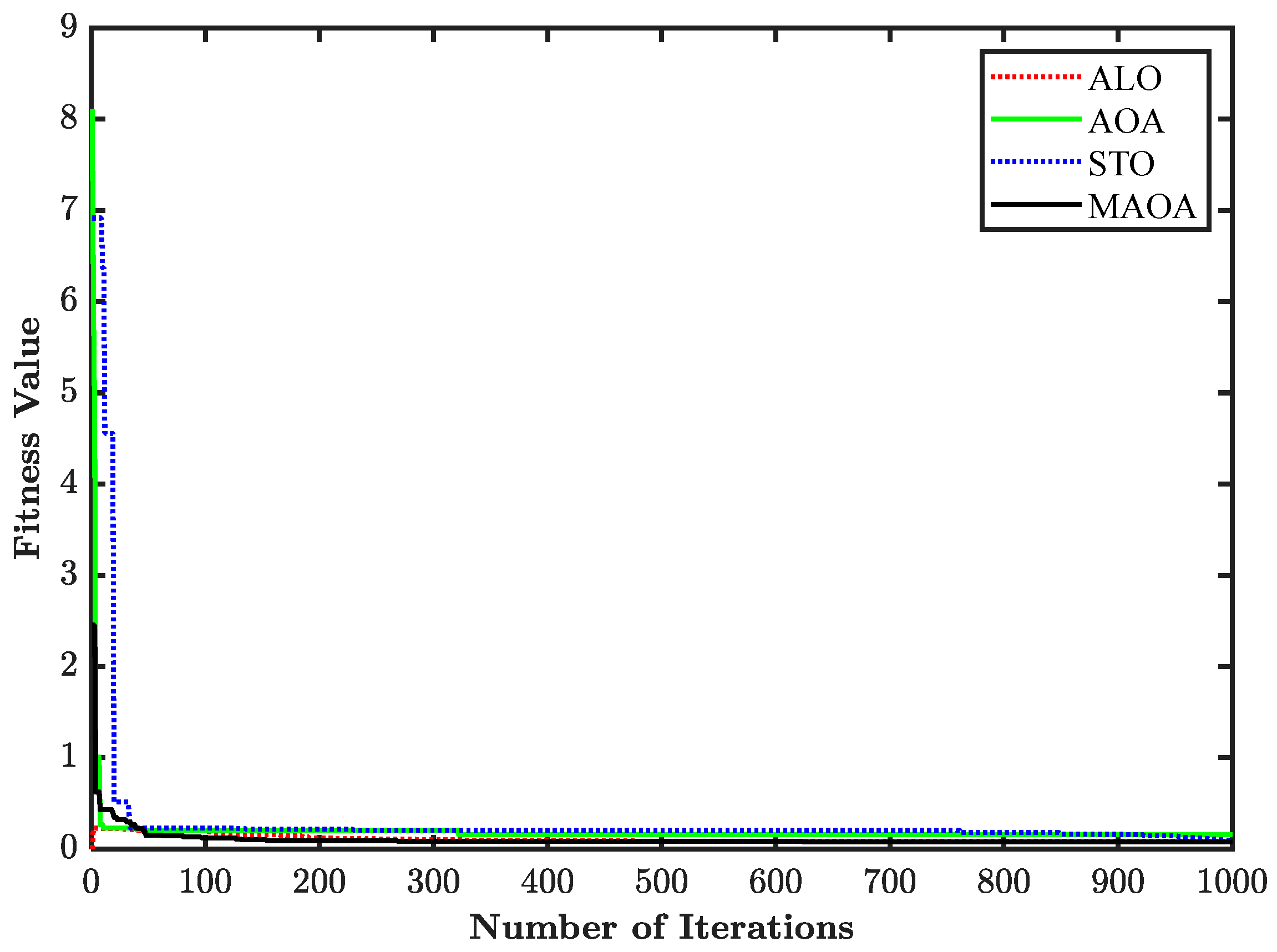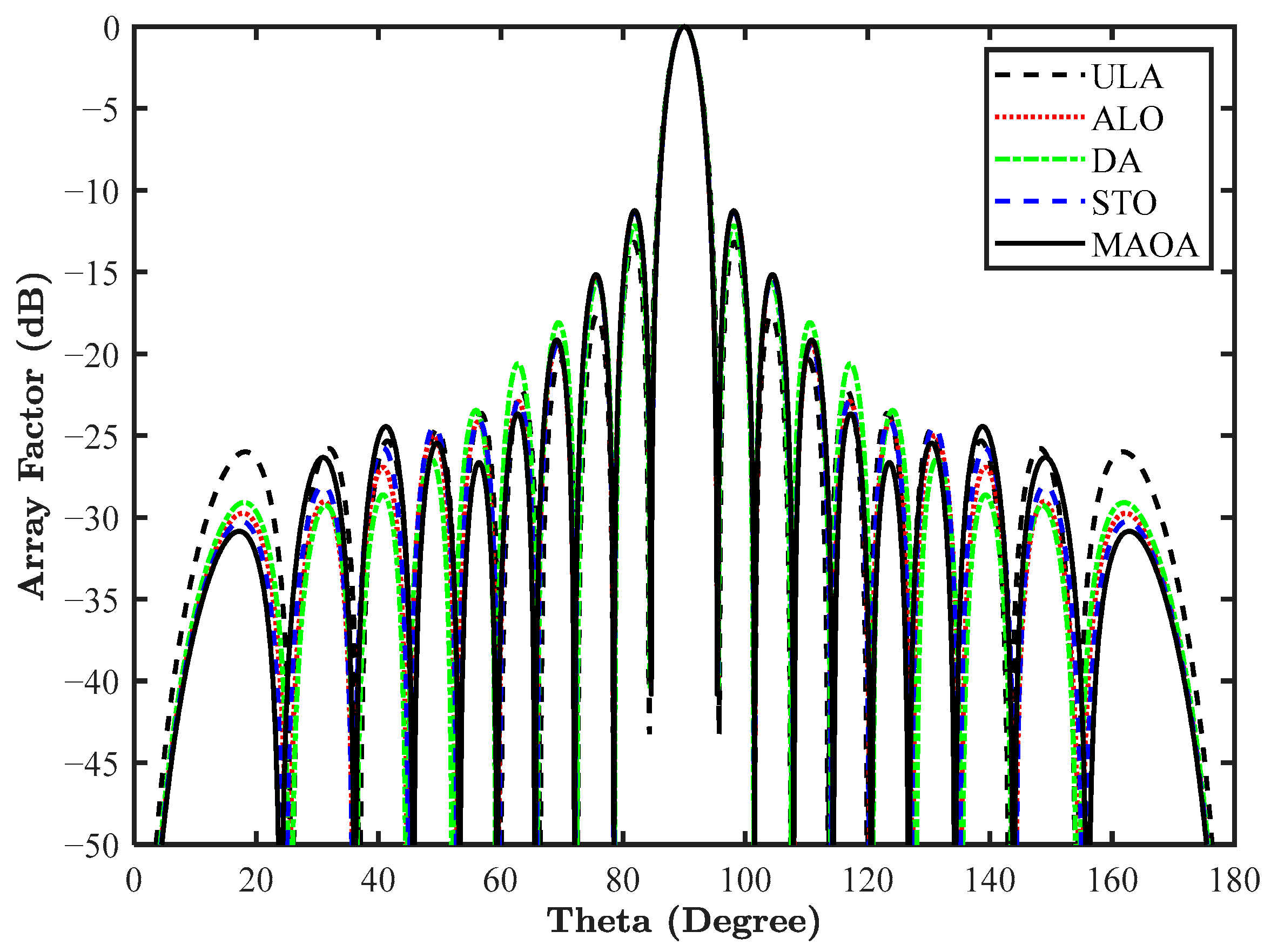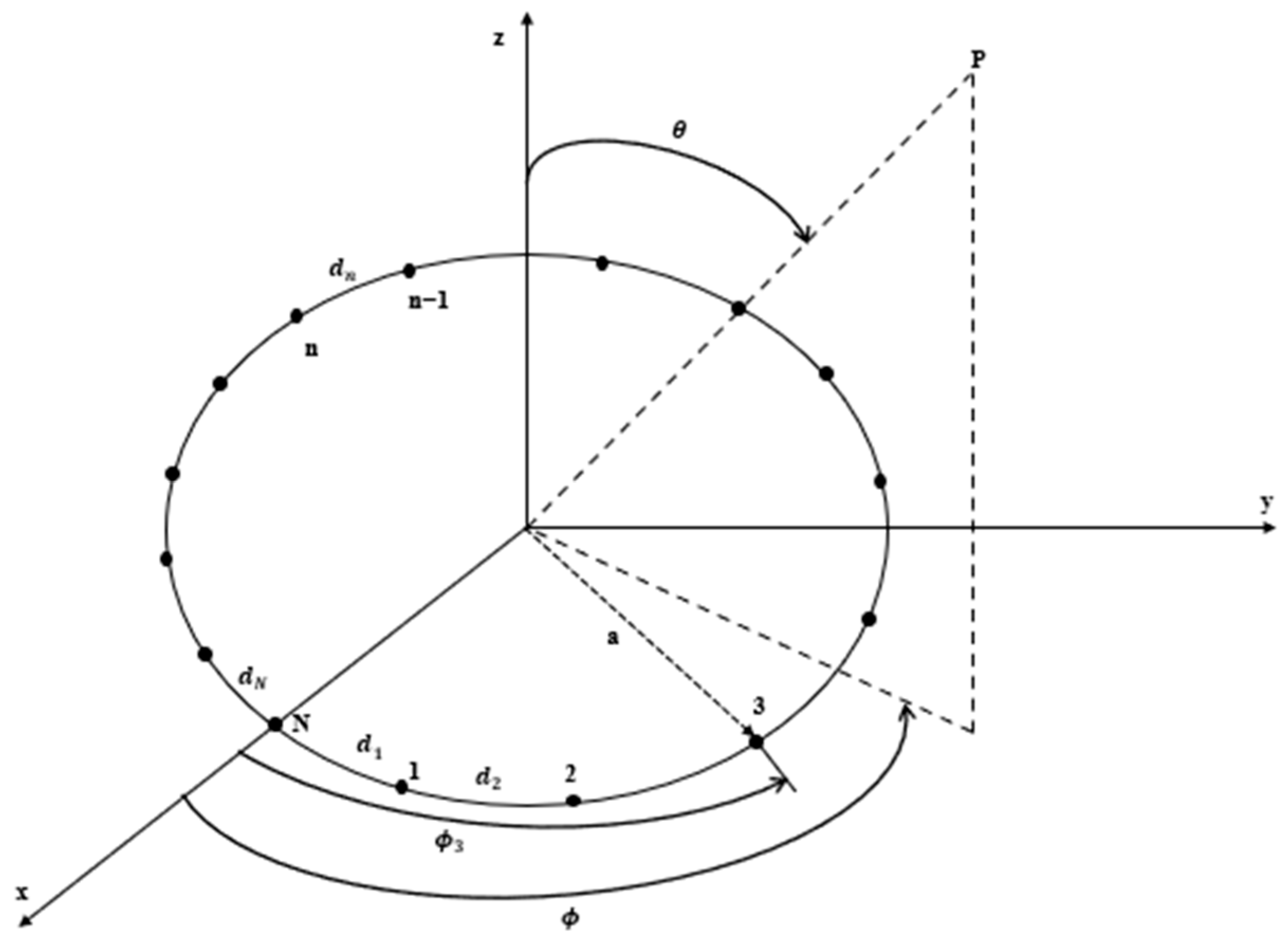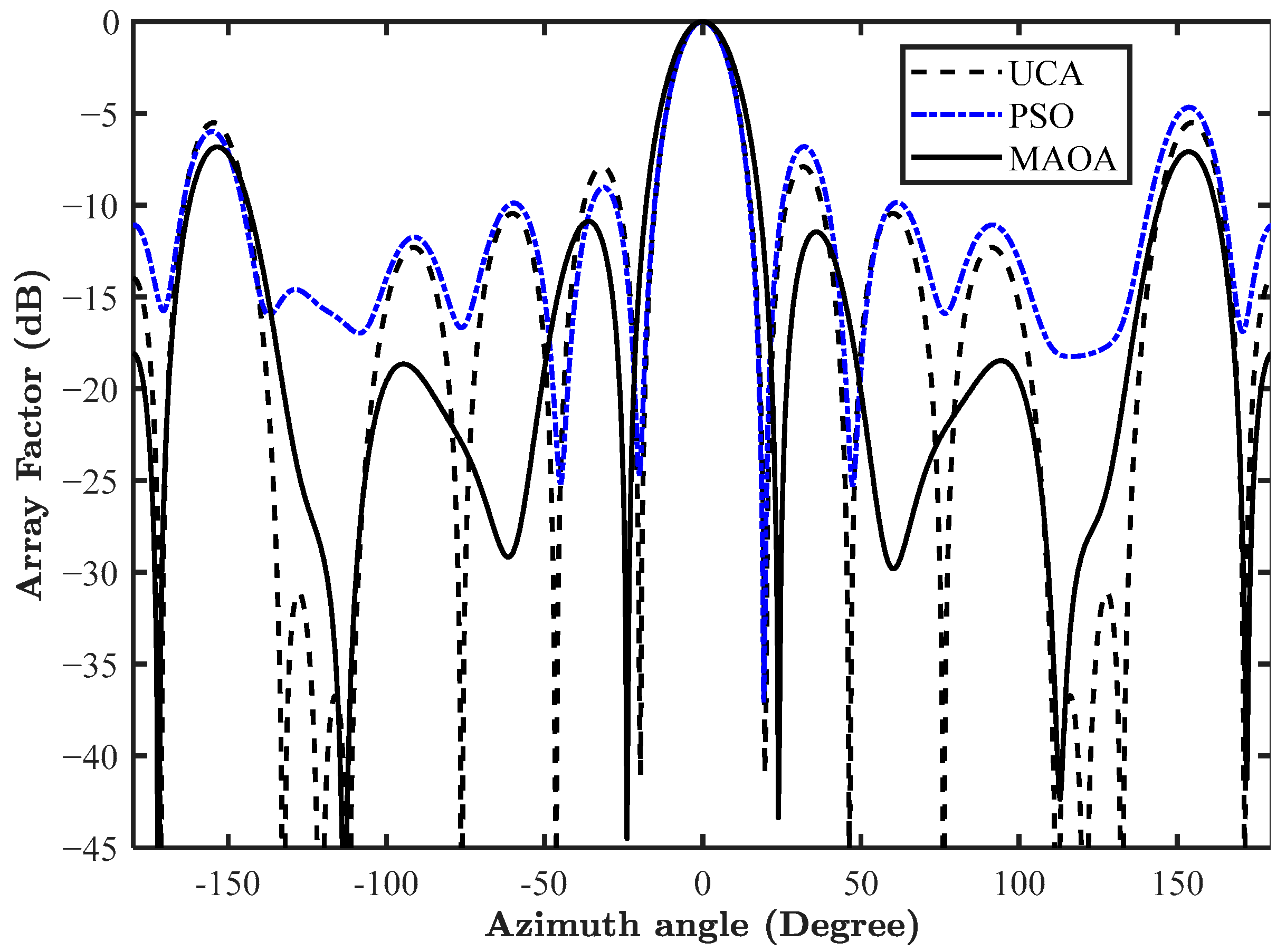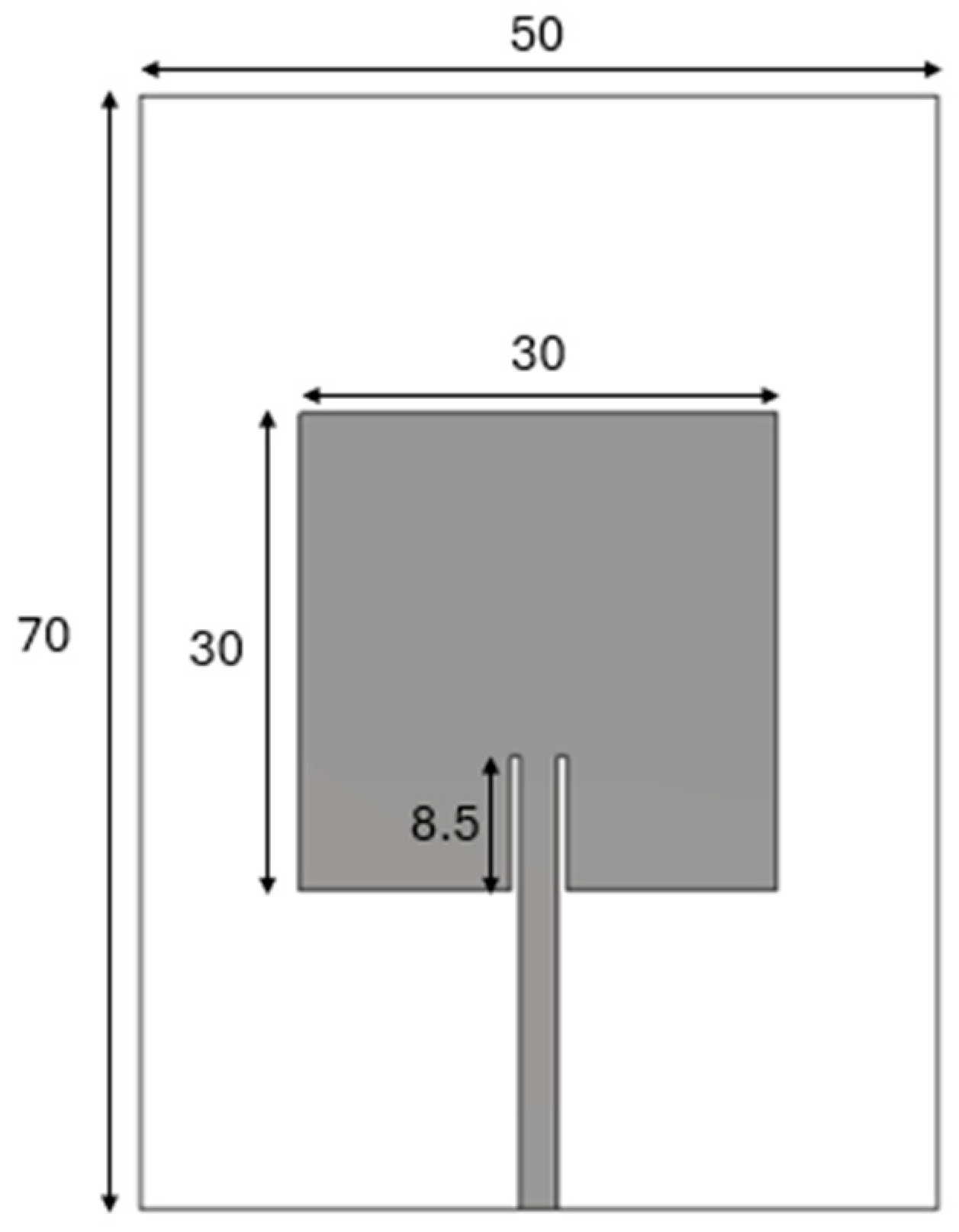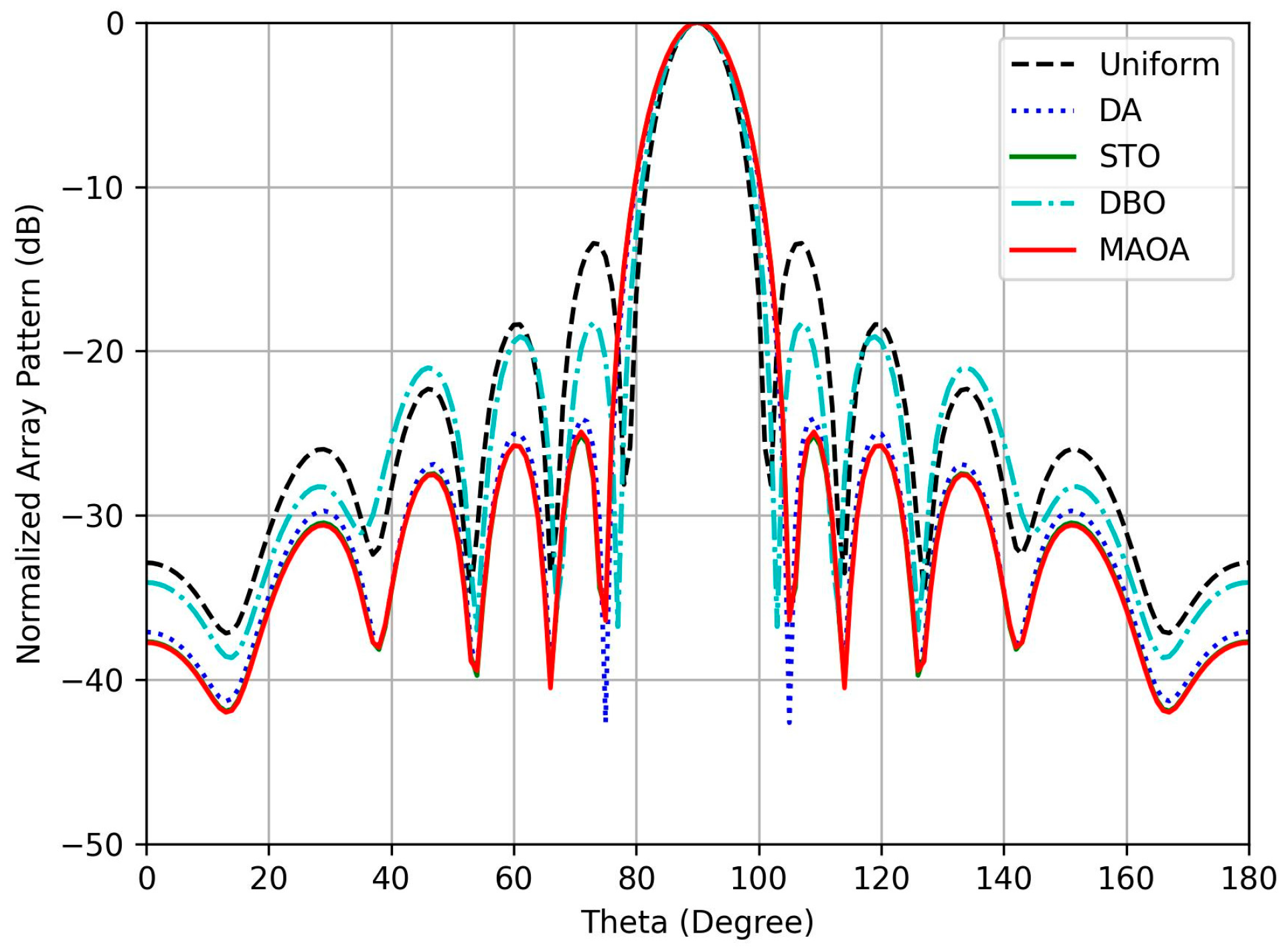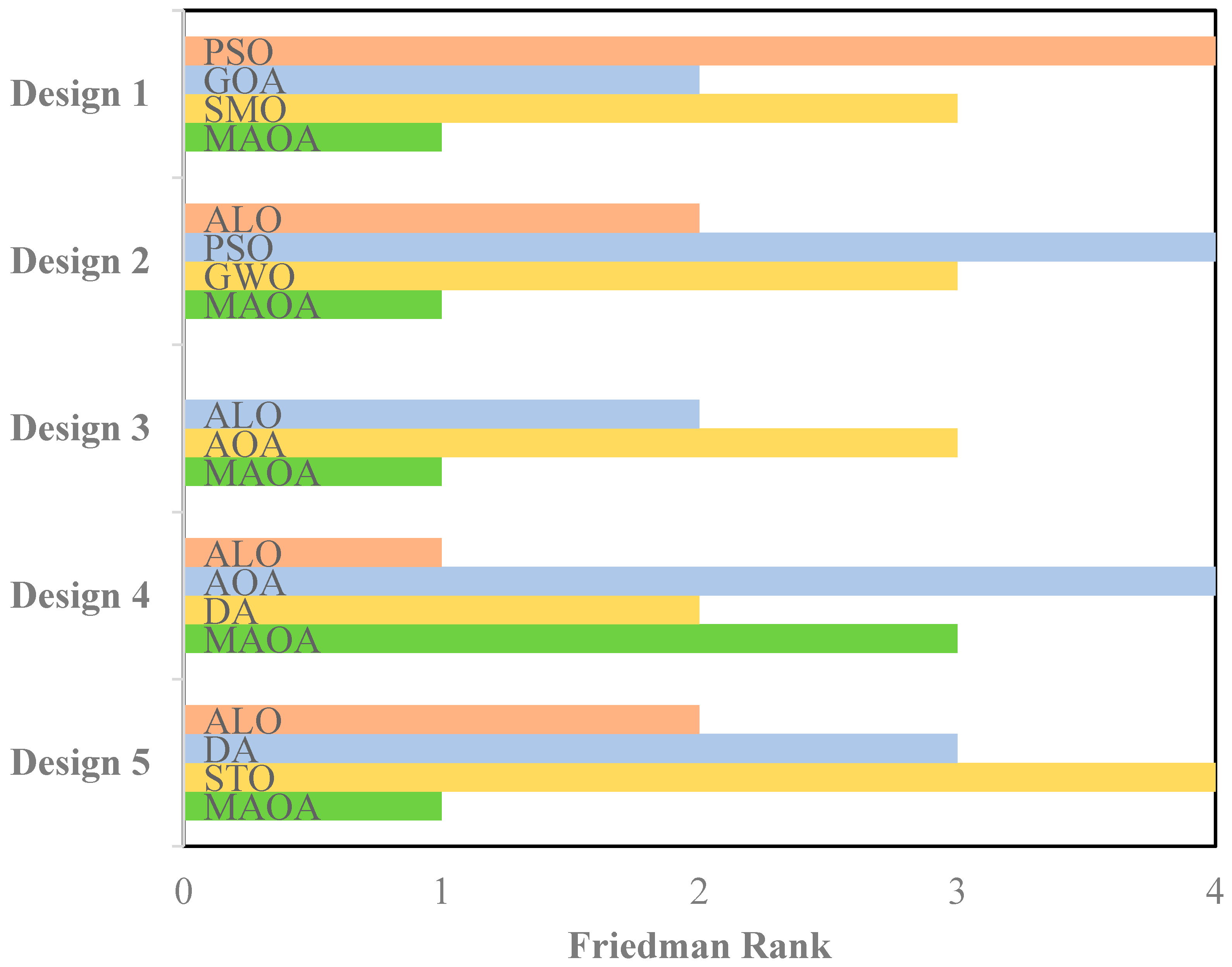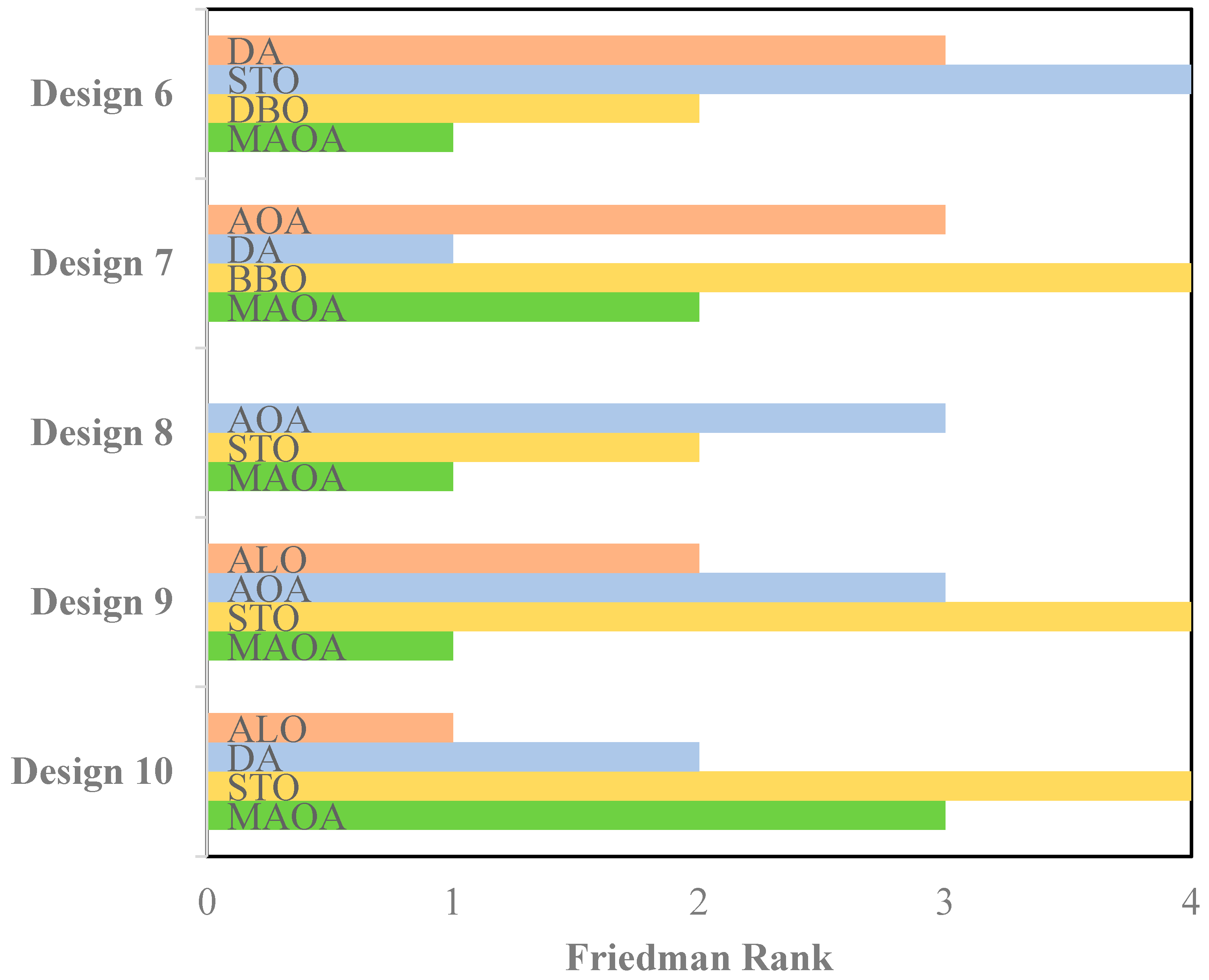1. Introduction
The rapid evolution in the field of communication technology significantly affects the routine behavior of humans in society. The widespread adoption of mobile communication is profoundly shaping modern lifestyles [
1]. In this dynamic environment, the importance of efficient antenna systems cannot be overstated, but their design and synthesis remain a complex and challenging task. One of the most sought-after and adopted layouts for this purpose is the linear antenna array (LAA); in its configuration, the number of antenna elements is placed in a linear fashion [
2]. Estimating the parameters of these antenna arrays for obtaining the desired radiation performance is called pattern synthesis. Mostly, the system is required to maintain a low SLL to overcome the interference effect that occurs with adjacent systems working within the same frequency range. A narrow first null beamwidth (FNBW) is also desired in the antenna array system, so that it shows a high level of directivity during its operation [
3]. Satisfying both the conditions of low SLL and narrow beamwidth simultaneously is very tedious work, because both aspects are dependent on each other. Improving one aspect may degrade the performance of the other [
4]. In many situations, the beamwidth and the system gain are compromised to reduce the SLL [
5]. The other requirement from the antenna array is that it should place the deeper nulls in the intended direction, so that the interfering sources are avoided, but a large electromagnetic population hinders these placements to a greater extent [
6]. So, the major aspects which are required in an antenna array are that it must have a low side lobe level with constant FNBW and that the nulls are oriented toward the directions from where the interference is coming from. The parameters that affect the radiation performance of an antenna array are the shape of the array, interelement spacing of the elements, current amplitude, and its phase [
7]. In an LAA, SLL minimization and placement of nulls in the desired direction are obtained by using two methods [
8]. The first is by optimizing the interelement spacing considering uniform current excitation; the second is by fixing the spacing constant and optimizing the amplitude of the excitation current [
9].
The optimization strategies are broadly classified into deterministic and stochastic techniques. The deterministic approach requires a good initial guess for its implementation, and its computational time is too high when handling complex optimization problems. Also, this type of approach is highly sensitive and prone to being confined in the local minima [
10]. However, stochastic approaches, which include metaheuristic algorithms, are mostly applied to handle complex optimization scenarios. Many developed metaheuristic approaches are influenced by natural phenomena and swarm intelligence [
11]. These approaches are well suited for performing pattern synthesis in an antenna array [
12]. Some of the evolutionary optimization algorithms applied to handle the electromagnetic problems of an antenna array are as follows: atom search [
13,
14], BAT algorithm [
15,
16], bacterial foraging [
17], CAT swarm [
2,
18,
19], dragonfly algorithm (DA) [
20], flower pollination [
21], grey wolf optimization (GWO) [
11,
12,
22], moth flame optimization (MFO) [
23], particle swarm optimization (PSO) [
4,
24], social group optimization algorithm [
25], Taguchi [
8,
26], biogeography based optimization (BBO) [
27], ant lion optimization (ALO) [
28], spider monkey optimization [
29], and many more. These smart algorithms are also helpful in optimizing the parameters of other kinds of antenna array configurations, such as concentric [
30], conformal [
31], and circular [
32] antenna arrays. Moreover, in [
33], the author explored swarm intelligence algorithms to improve the performance of multiple-input and multiple-output (MIMO) antennas [
34,
35].
The arithmetic optimization algorithm (AOA) is a recently proposed metaheuristic algorithm by Abualigah et al. in 2021 [
34]. The search mechanisms of AOA are influenced by the diverse distributive characteristics of four fundamental arithmetic functions known as division, multiplication, addition, and subtraction. These arithmetic operators are employed in AOA along with its unique mechanisms to balance exploration and exploitation in searching for new solutions within the solution space. Specifically, the division and multiplication operators promote exploration, enabling the population to navigate broader regions of the search space and identify more promising solutions. In contrast, the addition and subtraction operators facilitate exploitation, refining already discovered promising solution areas. Since its inception, AOA has gained recognition as a popular metaheuristic algorithm for solving a variety of real-world optimization problems [
35,
36,
37,
38,
39]. However, like other metaheuristic algorithms, AOA also suffers from some inherent shortcomings. The first shortcoming is the questionable quality of the initial population proposed by the stochastic-based conventional initialization techniques. The second limitation involves the over-reliance on the current best solution to direct the search procedure for all population members of AOA when using the four arithmetic operators. Additionally, the lack of a sophisticated learning phase within the AOA framework may limit its ability to prevent solutions from getting stuck in local optima. These shortcomings can impact the resilience of AOA, leading to early convergence, particularly when addressing complex optimization issues with challenging fitness landscapes, and resulting in suboptimal outcomes.
In this paper, an MAOA is proposed to address the shortcomings of the original AOA, aiming to enhance its robustness in solving difficult real-world optimization issues, like the pattern synthesis of LAA. The novelty of the research work presented lies in the following points:
Three key modifications are introduced in MAOA to achieve a balance between exploration and exploitation throughout the optimization process.
The first key modification involves designing a modified initialization plan that makes use of the chaotic maps and random opposition-based learning to generate an initial population with improved solution quality.
The second modification focuses on constructing unique guidance for each solution by utilizing the important information from other well-performing solutions, enabling each solution to search toward more promising regions without compromising population diversity.
The third modification incorporates an additional learning phase to refine the new solutions found through unique guidance by facilitating information exchange between different solutions at various dimensional levels.
Extensive simulation studies in the subsequent sections demonstrate that MAOA, with these three key modifications, significantly enhances optimization performance and delivers promising results in solving the complex problem of pattern synthesis in LAA.
The rest of the paper is framed as follows. LAA is briefly discussed in
Section 2. Following this, the optimization algorithm MAOA is discussed in
Section 3. Different designs of LAA and CAA synthesis, along with the MAOA optimized results of excitation current amplitudes, interelement spacing, and the array patterns, are highlighted in
Section 4. Finally,
Section 5 presents the findings and conclusion.
3. MAOA Algorithm
Since its inception in 2021, AOA and its variants have been used to solve a wide range of optimization problems. Despite its popularity, the original AOA has inherent limitations, particularly in balancing exploration and exploitation effectively when addressing more complex and real-world optimization problems.
To address these limitations, this paper introduces a new variant of AOA, namely the modified AOA (MAOA), that incorporates several key modifications to improve its ability in balancing exploration and exploitation, thereby enhancing its robustness for tackling more complex optimization challenges. The key modifications introduced in MAOA include the following: (a) a modified population initialization scheme that leverages the benefits of multiple chaotic maps and random-oppositional-based learning, (b) an innovative mechanism to provide unique guidance for each AOA solution to improve the search process, and (c) additional learning phases designed to preserve population diversity. Detailed explanations of each key modification are provided in the subsequent subsections.
3.1. Modified Initialization Scheme of MAOA
Similar to many other metaheuristic algorithms, the original AOA uses a random initialization procedure for the creation of the initial population. Although this approach is simple to implement, the stochastic nature of the conventional approach may not always guarantee good quality initial solutions because it does not fully exploit useful content from the search environment. Specifically, the random population initialization can lead to initial solutions being generated in local optima or in regions far from the global optimum, which compromises the robustness of the algorithm by increasing susceptibility to early convergence and reducing convergence efficiency.
To address the shortcomings of traditional initialization, a modified initialization method is designed for the proposed MAOA, aiming to create an initial population with improved solution quality by leveraging the strengths of a chaotic map and a random-oppositional-based learning mechanism (ROLM). Unlike the purely stochastic nature of random initialization, the ergodic behavior exhibited by the chaotic map allows for a more extensive search of the solution space, facilitating the creation of a more diverse initial population and thereby minimizing the likelihood of initialization in local optima. Additionally, the strong global search capabilities of ROLM are utilized to generate complementary opposite solutions for those initialized using the chaotic map, which can enhance the search process through broader navigation of the solution space. The mechanisms used in the modified initialization method of MAOA that engrave the chaotic maps and ROLM are described in detail below.
The first half of the MAOA population, i.e.,
, for
and
, is generated using the unique ergodic properties of a chaotic map to generate each dimensional component of the solutions in the first half of the population. Suppose that
denotes the initial value of the chaotic variable, which is randomly generated, and the updated value of this chaotic variable at any q-th iteration is denoted as
, where
, with Q being the maximum number of iterations for updating the chaotic variable. In this study, the circle chaotic map is employed in the modified initialization method to create the initial positions of the first half of the MAOA population. The circle chaotic map updates its chaotic variable at each q-th iteration as follows:
Let
denote the value of the chaotic variable after the final iteration (
Q). Referring to the lower (
) and upper (
) boundary limits of the
d-th dimension, the initial position in the
d-th dimension for each solution of the first half of the population is generated as follows:
The first half of the MAOA population is generated by iteratively applying Equations (11) and (12) across all dimensions (i.e., ) for solutions that have a population index of .
Although the circle chaotic map helps reduce the likelihood of initial solutions being trapped in local optima, it does not completely prevent these initial solutions from being generated in regions that are far away from the global optimum, which may deteriorate the convergence characteristics of the algorithm. To address this issue, ROLM is adopted into the modified initialization method to create the second half of the MAOA population by producing complementary opposite solutions for the first half of the population created using the circle chaotic map. The integration of ROLM in deriving the second half portion of the population as opposite solutions to the first half is expected to increase the likelihood of identifying more promising initial solutions by exploring a wider solution space. By applying ROLM to the first half of the population, the opposite solution for each member in the
d-th dimension of the first half is calculated to generate the second half of the population, denoted as
:
where
is a random real-valued number lying between 0 and 1, and
represents the solution in the second half region of the population, calculated as the random opposite of the corresponding solution in the first half of the population. Similarly, the second half region of the MAOA population is generated by iteratively applying Equation (13) across all dimensions (i.e.,
) for solutions having a population index of
.
The use of chaotic maps in the initialization phase provides a systematic yet pseudo-random means to ensure that solutions are well distributed across the search space. Unlike uniform random generation, which may result in clustered solutions or large unsampled regions, the circle chaotic map guarantees ergodicity, i.e., the ability to traverse every sub-region of the solution space given enough iterations. This makes the initial population structurally less prone to redundancy and more likely to contain individuals seeded in distinct basins of attraction. As a result, the likelihood of the entire population being concentrated near local minima is substantially reduced.
Additionally, the incorporation of ROLM ensures that every solution generated by the chaotic map has a corresponding opposite solution, located across the search boundary in the solution space. This strategic mirroring mechanism enhances the algorithm’s spatial reach from the outset. It not only boosts population diversity but also directly contributes to the global exploration potential of MAOA by effectively doubling the sampling range across each dimension. This broad initial coverage increases the probability of seeding individuals near the global optimum and simultaneously diminishes the collective bias toward local regions, especially in high-dimensional or multimodal optimization problems.
From a theoretical standpoint, define as the expected probability that a randomly generated solution falls into a local optimum’s attraction basin. For conventional random initialization, this value depends on the landscape structure but remains relatively high in multimodal scenarios. The adoption of chaotic sequences modifies this expectation by reducing the clustering tendency of initial points. Due to the inherent non-repetitive and deterministic spread of the circle chaotic map, the distribution of points is better dispersed, which lowers for a single solution, especially when compounded by dimensionality.
Now consider the effect of ROLM. For every solution in the d-th dimension initialized using the chaotic map, its oppositional pair is generated according to Equation (13). This mirroring means that even if lies within the vicinity of a local minimum, its opposite pair likely resides outside this region, unless the problem space is symmetric and unimodal. Statistically, the inclusion of oppositional pairs increases the effective sampling coverage of the initialization process. This expansion of the initial population through both chaotic mapping and its ROLM-based opposites effectively broadens the search front. Since each ROLM-generated solution reflects across the boundaries of the decision space, the overall coverage of the initialization process is approximately doubled in terms of spatial reach compared to conventional random initialization. Formally, if denotes the effective subset of the search space explored by the initial population, and denotes the full domain, then we can intuitively state . This relation assumes that oppositional solutions are distributed in largely non-overlapping subregions of , which holds true in high-dimensional and non-symmetric landscapes. Although this is an empirical approximation rather than a strict mathematical guarantee, it provides useful insight into why the MAOA initialization scheme offers stronger robustness against local convergence traps.
Figure 2 presents the flowchart of the modified initialization method used to create the initial population of MAOA. The first and second halves of the population created using the chaotic map and ROLM, respectively, are stored in the set variable P. The fitness value of each n-th solution in P is evaluated as
. For a minimization problem, a smaller value of
is desirable, whereas for a maximization problem, a larger value of
is preferred. The fitness evaluation process is repeated until all initial solutions in P are evaluated. The best-performing solution within the P is then identified, with its position vector and fitness value represented as
and
, respectively.
3.2. Construction of Unique Guidance for MAOA
Upon carefully examining the four arithmetic operators of the original AOA, as shown in Equations (8) and (10), it is evident that all these four operators share a common attribute, i.e., the current best solution () is consistently used to guide and adjust the search trajectory of all solutions throughout the optimization process. While this approach may help to accelerate the converging nature of the original AOA during the early stages of optimization, the frequency of updating tends to decrease in the middle or latter stages due to a loss of population diversity. In unfavorable scenarios where becomes trapped in a local optimum early in the optimization process, especially when dealing with complex optimization problems featuring challenging fitness landscapes, the remaining solutions are likely to be misguided toward these suboptimal regions, resulting in premature convergence.
To handle the limitations encountered in the original AOA, the concept of unique guidance is introduced in the proposed MAOA. It is assumed that while contains the most promising information at the current stage of optimization, it may not be ideal to use it as the sole guidance for all solutions due to the risk of premature convergence, particularly when dealing with complex optimization issues. Besides , other well-performing solutions in the population also contain valuable information that can be utilized to guide the search process. Compared to using only , leveraging multiple high-quality solutions to guide others is expected to direct the population toward promising regions while preserving population diversity. Motivated by this idea, the concept of unique guidance is incorporated into the proposed MAOA, enabling the search process of each solution to be influenced by a uniquely selected and well-performing guide. The mechanisms used to construct unique guidance for each solution in the MAOA population are detailed below.
During the iterative search process, the MAOA population is first sorted based on the fitness values of the solutions in descending order, i.e., from the worst to the best fitness values. In other words, the worse-performing solutions are assigned smaller population indices, while the better-performing solutions are assigned larger population indices. After completing the sorting process, a set variable is defined for each n-th solution having a population index of to hold the population indices of other solutions that have better fitness values than the n-th solution. Evidently, the set associated with the worse-performing solutions contains more elements compared to those associated with better-performing solutions.
Using the set
for each n-th solution, a better-performing solution is randomly selected from
to be used as unique guidance for adjusting the search trajectory of the n-th solution during optimization. Let
represent the population index of a better-performing solution randomly selected from
, and let
be the unique guidance assigned to the n-th solution. Then,
where
is an operator used to randomly select an element from the given set
for each n-th solution.
It is noteworthy that Equations (14) and (15) are not applicable for the best-performing solution with the population index
because it has no other superior solution to serve as its unique guidance. In this case, a set variable
is constructed for the best-performing
N-th solution, enabling it to select any other solution from
as its unique guidance to explore wider regions of the solution space. Let
represent the population index of any solution randomly selected from
, and let
be the unique guidance assigned to the
N-th solution. Then,
The concept of unique guidance significantly enhances the resilience of MAOA to premature convergence by allowing each solution to perform a search under the influence of a distinct elite peer. In contrast to traditional global-best-based mechanisms, where all individuals are directed toward the same attractor, the unique guidance strategy promotes multi-attractor dynamics. Each solution is influenced by a superior individual selected from a personal set of better-performing peers, enabling diverse directional movement and preventing the entire population from collapsing into a narrow convergence cluster too early.
This behavioral shift is particularly beneficial when navigating complex fitness landscapes that contain multiple deceptive local optima. If all solutions are attracted to a single best solution , and that solution resides in a suboptimal basin, the entire population may converge prematurely. However, under the unique guidance strategy, solutions are scattered across distinct regions, each influenced by different high-quality peers. This promotes competitive learning across niches, increases the diversity of search paths, and simultaneously maintains focus on high-potential regions. Additionally, even the best solution is exempt from rigid elitism, as it is guided by a randomly selected peer. This intentional disruption encourages continued exploration even among top individuals, helping to break the conventional greedy loop often observed in elitist metaheuristics.
From a technical standpoint, the unique guidance mechanism transforms the guidance model from a static, globally centralized structure into a stochastic dominance-based framework. Let
denote the set of solutions with better fitness than the
n-th solution
, such that
, where the population is sorted in descending order, i.e., from the worst to the best fitness values. Since the best solution
(at population index
N) is always a member of
, the probability that any
selects
as its guide is as follows:
This indicates that better-performing solutions (with larger indices n) have fewer options in , and hence a higher probability of selecting as their guide. On the other hand, the worse solutions (with smaller n) have access to a wider pool of elite guides, reducing the probability of following a single peer. This adaptive design reinforces exploitation among superior individuals while promoting exploration among weaker ones due to their access to greater guidance diversity.
For the best solution
, which has no superior individuals, guidance is randomly selected from all other population members:
This intentional randomness ensures that even the top solution participates in exploratory behavior, avoiding stagnation and reinforcing diversity at the elite level.
Let denote the average pairwise Euclidean distance between solutions at iteration t. In the original AOA, rapidly as all solutions converge to , leading to early stagnation. In contrast, the unique guidance strategy in MOAO preserves diversity such that , where is a positive constant representing a minimal diversity threshold. This helps MAOA sustain search variation longer through early and mid-phases, increasing the likelihood of discovering latent optima through “late bloomers” in the population.
Furthermore, the proposed guidance strategy maintains population diversity across generations by preventing premature clustering around a single guide. It allows search trajectories to adapt dynamically based on fitness rank, reinforcing convergence in promising regions while ensuring broad exploration. This mechanism effectively replaces deterministic elitism with a probabilistic leadership model, allowing MAOA to strike a more effective and flexible balance between exploration and exploitation.
Figure 3 illustrates the flowchart used to derive the unique guidance (
) for each n-th solution, where
, which is subsequently used to replace
in calculating the new position of each n-th solution during the exploration and exploitation phases. Let
represent the d-th dimension of the unique guidance assigned to the n-th solution. The d-th dimension of the new position vector for the n-th solution (
) is calculated during the exploration phase of MAOA (i.e., when
) as follows:
During the exploitation phase of MAOA (i.e., when
), the new position of the d-th dimension for the n-th solution
is calculated as follows:
Compared to the original AOA, the exploration and exploitation phases of MAOA, as defined in Equations (20) and (21), incorporate valuable information from other well-performing solutions beyond offering a unique guidance scheme for each n-th learner. Since this unique guidance is derived from a subset of population members that are superior to the n-th learner, it is expected to provide effective guidance while still preserving population diversity.
3.3. Additional Learning Phase of MAOA
The unique guidance derived for each n-th solution in the previous subsection helps promote the population diversity of MAOA without compromising each solution’s ability to explore promising parts of the solution space. To enhance this process further, mutual learning is introduced as an additional learning phase in the proposed MAOA, enabling each new solution to interact with other solutions that may contain valuable information in certain dimensions. For each n-th solution, after obtaining the new solution in each d-th dimension, the mutual learning phase allows the new solution () to learn from another randomly selected solution in the original population. The mechanisms of the mutual learning phase in the proposed MAOA are described as follows.
Let
represent a set containing the population indices of other solutions that the
n-th learner can interact with during the mutual learning phase. The new solution
can interact with all other solutions except itself. During the mutual learning phase, the
n-th solution randomly selects an element from
to determine the population index of the solution it will interact with when updating the
d-th component of its new solution (
), as follows:
where
represents the
d-th component of the mutual learner that interacts with the n-th solution for dimension d (i.e.,
). Notably, both Equations (22) and (23) are applied for
D times to ensure that different dimensional components of a mutual learner can be contributed by different potential solutions from the original population.
Let
represents the
d-th component of the updated solution for the
n-th solution after interacting with the mutual learner (i.e.,
), calculated as follows:
The updated solutions for all population members of MAOA are generated by iteratively applying Equations (22)–(24) across all dimensions (i.e.,
) for all solutions with population indices of
.
Figure 4 illustrates the mutual learning mechanism incorporated into the proposed MAOA.
The mutual learning phase serves as a crucial mechanism in MAOA to further sustain population diversity and mitigate stagnation risks, especially in the mid-to-late stages of the search process. While the unique guidance mechanism already promotes distributed learning by directing each individual toward a better peer, the additional learning phase introduces a second layer of interaction that facilitates decentralized knowledge diffusion. This form of structured interaction allows solutions to access complementary information from randomly selected peers, not necessarily limited to those superior in fitness. In doing so, MAOA avoids over-reliance on elite solutions and enables alternative paths to emerge, thus enhancing the algorithm’s resilience against deceptive local optima.
Most importantly, this mutual learning phase emulates a collaborative refinement strategy where partial solution components can evolve under the influence of different members of the population. Unlike conventional elitist-based updates that propagate dominant traits globally, this phase maintains diversity by decentralizing the influence map across the solution space. It effectively introduces a multi-source learning framework in which each dimension of a solution can be independently updated based on different references. This design fosters continual exploration and structural adaptability, which are crucial in complex or rotated landscapes where no single guide offers universal improvement. By doing so, MAOA ensures that even mediocre individuals are not prematurely excluded from the search process, providing late-blooming candidates a chance to emerge as high-quality solutions.
From a technical standpoint, the mutual learning phase introduces a fine-grained, dimension-level recombination scheme based on random peer selection. Recall that denotes the index set of all other individuals excluding the n-th solution. For each d-th dimension, the n-th solution selects a mutual learner with a population index of and updates the d-th component of its new position based on Equation (24). This means that each component of a solution may be influenced by a different peer, unlike conventional update rules that apply a uniform direction vector across all dimensions. Such cross-dimensional recombination promotes heterogeneous movement patterns, leading to higher inter-individual variability. As each component is drawn from a different landscape sample, the resulting solution has a higher probability of escaping local attractors. This randomized, dimension-wise inheritance reduces the likelihood of structural similarity in the population, thereby maintaining a higher average pairwise diversity across iterations.
Furthermore, the mutual learning process operates without introducing new control parameters or computational overhead, making it a lightweight yet powerful extension. Compared to techniques such as crossover in evolutionary algorithms or learning automata in particle-based methods, this approach avoids explicit combination weights or directional bias. It is thus less susceptible to premature convergence due to parameter misconfiguration. Instead, its randomness is functionally constrained, i.e., each dimension is updated using feasible and existing values from the population, thus preserving the feasibility and search-space consistency of the solution. This dual-level update process (unique guidance + mutual learning) gives MAOA a layered learning structure that adaptively shifts between directed convergence and stochastic recombination, ensuring a well-balanced trade-off between exploitation and exploration without compromising convergence speed.
3.5. Computational Complexity Analysis of MAOA
The computational complexity of the MAOA is analyzed using Big O notation to assess its scalability with respect to the population size N, dimensionality D, and maximum number of iterations . The proposed MAOA integrates three major innovations over the original AOA, i.e., a modified initialization strategy using chaotic maps and ROLM, a unique guidance mechanism for solution update, and an additional mutual learning phase. Each component is carefully examined below.
The initialization phase of MAOA is divided into two stages, i.e., the first half of the population is generated using the circle chaotic map, and the second half is constructed via the ROLM. For each solution, the chaotic map requires Q internal iterations to compute chaotic variables before transforming them into positional values across D dimensions. Assuming Q is constant, the cost to initialize half the population is . Similarly, ROLM operates over all D dimensions for the second half of the population, also incurring . Thus, the total complexity for population initialization of MAOA is .
The core iterative phase of MAOA consists of three nested operations, namely computing unique guidance, updating positions through exploration/exploitation arithmetic operators, and performing mutual learning. Each of these operations involves processing over all individuals and all dimensions.
In the unique guidance phase, the MAOA first sorts the population by fitness, which has a cost of . Then, for each solution, it creates a ranked set , randomly samples a guide from , and updates position based on guidance rules. This involves operations per iteration. Hence, the guidance phase per iteration is . During the solution update phase using arithmetic operators, the new position of each solution is calculated across all D dimensions, incorporating guidance from the selected peer. The arithmetic update operations involve simple expressions (addition, subtraction, multiplication, and division), which result in per iteration.
The mutual learning phase allows each solution to independently update its dimensions by learning from a randomly selected peer solution. For each d-th dimension, the solution selects a random mutual, and the corresponding component is adopted based on Equation (24). This dimension-wise recombination is done for all N solutions, across all D dimensions, resulting in another complexity per iteration.
Finally, after the new and original populations are merged, MAOA performs a sorting step on the merged population of size 2N, requiring times. The top N individuals are then selected for the next generation in constant time relative to sorting. Summarizing the total time complexity per iteration incurred by the sorting, guidance, position updates, and mutual learning, the total per-iteration complexity of MAOA becomes . Considering the algorithm runs for iterations, the overall computational complexity of MAOA becomes .
This expression shows that MAOA scales linearly with the number of dimensions D and the number of iterations , and near-linearly with the population size N, aside from the term introduced by sorting. Notably, despite introducing multiple learning mechanisms, the algorithm avoids excessive overhead by keeping update operations lightweight and avoiding extra nested loops or parameter tuning routines. This makes MAOA computationally competitive and suitable for large-scale or high-dimensional optimization tasks.
